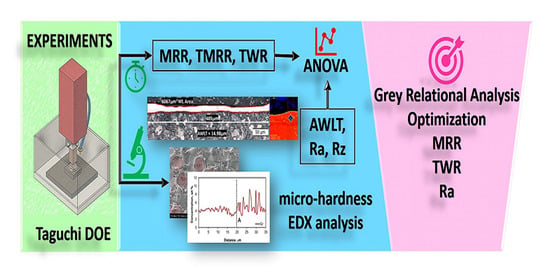An Optimalization Study on the Surface Texture and Machining Parameters of 60CrMoV18-5 Steel by EDM †
Abstract
:1. Introduction
2. Materials and Methods
2.1. The Taguchi DOE Method
2.2. Grey Relational Analysis
3. Results and Discussion
3.1. Material Removal Rate, Tool Material Removal Rate, and Tool Wear Ratio
3.2. Surface Roughness, Average White Layer Thickness, and Heat Affected Zone
3.3. Optimization Based on Grey Relational Analysis
4. Conclusions
- The MRR is mainly affected by the pulse-on current, while the pulse-on time and the open-circuit voltage have a minor and vague impact on MRR. Additionally, for the low pulse-on currents (5 and 7 A) the MRR remains almost stable for all the machining parameter combinations.
- The TMRR is mainly affected by the combination of the machining parameters and not as a direct result of a specific change in the machining parameters.
- The lowest TWR was measured for the higher pulse-on times (i.e., 50 and 100 μs), while it was also almost constant regardless of the other machining conditions (i.e., pulse-on current and open-circuit voltage).
- The roughness values (Ra, Rz) mainly increase as the pulse-on time and current increase, although an increase of the open-circuit voltage reduces the surface roughness.
- The AWLT values significantly deviate for the lower open-circuit voltages depending on the machining parameters combination. The lowest WL thickness and with minimum deviation was measured for the higher Vos (i.e., 160 and 200 V), a result that can be ascribed to the capability of more efficient flushing and thus better molten material removal.
- The WL has over 400% increased micro-hardness compared with the bulk material. This increase in the WL micro-hardness is mainly attributed to the material’s amorphization since, according to EDX maps, no change in the material’s chemical composition occurred.
- The machined surfaces are covered by craters, whose central area is smooth, and their rim is made up of bulky formations. Moreover, pockmarks, microcracks, microporosity and voids are observed to a different degree depending on the machining conditions.
- By employing the GRA, a multi-objectives optimization can be achieved, even for performance indexes that are competitive (i.e., MRR, TWR, and Ra). Nevertheless, it is substantial that only the by case absolutely necessary performance indexes should be considered in order for a clear result tο emerge.
- More specifically, according to the GRG grades during the optimization, in order to achieve better TWR-MRR-Ra, the optimal combination of parameters is 17 A, 50 μs, and 120 V, although when we considered the AWLT, the optimal parameters decreased the pulse-on time and current (5 A, 50 μs, and 160 V).
Author Contributions
Funding
Institutional Review Board Statement
Informed Consent Statement
Data Availability Statement
Conflicts of Interest
Nomenclature
| EDM | Electrical Discharge Machining | - |
| AWLT | Average White Layer Thickness | μm |
| Efin | Electrode weight after machining | gr |
| Est | Electrode weight before machining | gr |
| HAZ | Heat Affected Zone | μm |
| Ip | Pulse-on current | A |
| MRR | Material Removal Rate | mm3/min |
| Ra | Mean Roughness | μm |
| Rz | Maximum peak to valley height | μm |
| SCD | Surface Crack Density | m/mm2 |
| SQ | Surface Quality | - |
| ST | Surface Topography | - |
| TMRR | Tool Material Removal Rate | mm3/min |
| Ton | Pulse-on time | μs |
| TWR | Tool Wear Ratio | % |
| tmach | Mahining time | min |
| Wfin | Workpiece weight after machining | gr |
| Wst | Workpiece weight before machining | gr |
| WL | White Layer | - |
| ρel | Electrode density | gr/mm3 |
| ρw | Workpiece density | gr/mm3 |
| Γ | Grey Relational Grades | - |
| γ | Grey Relational Coefficients | - |
References
- Jahan, M.P. Electrical Discharge Machining (EDM): Types, Technologies and Applications; Nova Science Publishers: New York, NY, USA, 2015. [Google Scholar]
- Jameson, E.C. Electrical Discharge Machining; Society of Manufacturing Engineers: Southfield, MI, USA, 2001. [Google Scholar]
- Karmiris-Obratański, P.; Papazoglou, E.L.; Leszczyńska-Madej, B.; Zagórski, K.; Markopoulos, A.P. Surface and Subsurface Quality of Titanium Grade 23 Machined by Electro Discharge Machining. Materials 2022, 15, 164. [Google Scholar] [CrossRef]
- Abu Qudeiri, J.E.; Mourad, A.-H.I.; Ziout, A.; Abidi, M.H.; Elkaseer, A. Electric discharge machining of titanium and its alloys: Review. Int. J. Adv. Manuf. Technol. 2018, 96, 1319–1339. [Google Scholar] [CrossRef]
- Abu Qudeiri, J.E.; Saleh, A.; Ziout, A.; Mourad, A.-H.I.; Abidi, M.H.; Elkaseer, A. Advanced Electric Discharge Machining of Stainless Steels: Assessment of the State of the Art, Gaps and Future Prospect. Materials 2019, 12, 907. [Google Scholar] [CrossRef] [Green Version]
- Manjaiah, M.; Narendranath, S.; Basavarajappa, S. A review on machining of titanium based alloys using EDM and WEDM. Rev. Adv. Mater. Sci. 2014, 36, 89–111. [Google Scholar]
- Abu Qudeiri, J.E.; Zaiout, A.; Mourad, A.-H.I.; Abidi, M.H.; Elkaseer, A. Principles and Characteristics of Different EDM Processes in Machining Tool and Die Steels. Appl. Sci. 2020, 10, 2082. [Google Scholar] [CrossRef] [Green Version]
- Lim, L.C.; Lee, L.C.; Wong, Y.S.; Lu, H.H. Solidification microstructure of electrodischarge machined surfaces of tool steels. Mater. Sci. Technol. 1991, 7, 239–248. [Google Scholar] [CrossRef]
- Haron, C.C.; Ghani, J.A.; Burhanuddin, Y.; Seong, Y.K.; Swee, C.Y. Copper and graphite electrodes performance in electrical-discharge machining of XW42 tool steel. J. Mater. Processing Technol. 2008, 201, 570–573. [Google Scholar] [CrossRef]
- Younis, M.A.; Abbas, M.S.; Gouda, M.A.; Mahmoud, F.H.; Abd Allah, S.A. Effect of electrode material on electrical discharge machining of tool steel surface. Ain Shams Eng. J. 2015, 6, 977–986. [Google Scholar] [CrossRef] [Green Version]
- Sharif, S.; Safiei, W.; Mansor, A.F.; Isa, M.H.M.; Saad, R.M. Experimental Study of Electrical Discharge Machine (die sinking) on Stainless Steel 316L Using Design of Experiment. Procedia Manuf. 2015, 2, 147–152. [Google Scholar] [CrossRef] [Green Version]
- Barenji, R.V.; Pourasl, H.H.; Khojastehnezhad, V.M. Electrical discharge machining of the AISI D6 tool steel: Prediction and modeling of the material removal rate and tool wear ratio. Precis. Eng. 2016, 45, 435–444. [Google Scholar] [CrossRef]
- Mishra, B.P.; Routara, B.C. Comparative Analysis of the Performance Effectiveness of Sinking Electrical Discharge Machining (EDM) process with Enhancement in Hardness of the parent EN-31 Alloy Steel. Mater. Today Proc. 2017, 4, 10235–10239. [Google Scholar] [CrossRef]
- Choudhary, R.; Singh, G. Effects of process parameters on the performance of electrical discharge machining of AISI M42 high speed tool steel alloy. Mater. Today Proc. 2018, 5, 6313–6320. [Google Scholar] [CrossRef]
- Bahgat, M.M.; Shash, A.Y.; Abd-Rabou, M.; El-Mahallawi, I.S. Influence of process parameters in electrical discharge machining on H13 die steel. Heliyon 2019, 5, e01813. [Google Scholar] [CrossRef] [Green Version]
- Rani, S.S.; Sundari, V.K.; Jose, P.S.H.; Sivaranjani, S.; Stalin, B.; Pritima, D. Enrichment of material subtraction rate on Eglin steel using electrical discharge machining process through modification of electrical circuits. Mater. Today Proc. 2019, 33, 4428–4430. [Google Scholar] [CrossRef]
- Sahayaraj, J.M.; Arravind, R.; Subramanian, P.; Marichamy, S.; Stalin, B. Artificial neural network based prediction of responses on eglin steel using electrical discharge machining process. Mater. Today Proc. 2019, 33, 4417–4419. [Google Scholar] [CrossRef]
- Dinesh, S.; Karthikeyan, T.; Vijayan, V. Powder mixed electrical discharge machining of oil hardened non shrinking steel die steel–Optimization and investigation. Mater. Today Proc. 2020, 37, 345–350. [Google Scholar] [CrossRef]
- Huu, P.N. Multi-objective optimization in titanium powder mixed electrical discharge machining process parameters for die steels. Alex. Eng. J. 2020, 59, 4063–4079. [Google Scholar] [CrossRef]
- Jeavudeen, S.; Jailani, H.S.; Murugan, M. Effect of process parameters in the machining of Titanium alloy and high speed steel in powder mixed electrical discharge machining process. Mater. Today Proc. 2020, 27, 615–619. [Google Scholar] [CrossRef]
- Gopal, R.; Thangadurai, K.R.; Thirunavukkarasu, K. Behavior of ECAP processed copper electrodes in electrical discharge machining of AISI H13 steel. Mater. Today Proc. 2020, 21, 295–298. [Google Scholar] [CrossRef]
- Mohanty, R.K.; Saini, S.K. Experimental investigation on electrical discharge machining of steel. Mater. Today Proc. 2021, 44, 1949–1952. [Google Scholar] [CrossRef]
- Papazoglou, E.L.; Karmiris-Obratański, P.; Leszczyńska-Madej, B.; Markopoulos, A.P. A study on Electrical Discharge Machining of Titanium Grade2 with experimental and theoretical analysis. Sci. Rep. 2021, 11, 8971. [Google Scholar] [CrossRef] [PubMed]
- Roy, R.K. Design of Experiments (DOE) Using the Taguchi Approach; John Wiley & Sons: Hoboken, NJ, USA, 2001. [Google Scholar]
- Ertugrul, I. Grey Relational Analysis Approach in Academic Performance Comparison of University: A Case Study of Turkish Universities. Eur. Sci. J. 2016, 12, 128–139. [Google Scholar]
- Shabgard, M.; Ahmadi, R.; Seyedzavvar, M.; Oliaei, S.N.B. Mathematical and numerical modeling of the effect of input-parameters on the flushing efficiency of plasma channel in EDM process. Int. J. Mach. Tools Manuf. 2013, 65, 79–87. [Google Scholar] [CrossRef]
- Verma, V.; Sahu, R. Process parameter optimization of die-sinking EDM on Titanium grade–V alloy (Ti6Al4V) using full factorial design approach. Mater. Today Proc. 2017, 4, 1893–1899. [Google Scholar] [CrossRef]
- Valaki, J.B.; Rathod, P.P. Assessment of operational feasibility of waste vegetable oil based bio-dielectric fluid for sustainable electric discharge machining (EDM). Int. J. Adv. Manuf. Technol. 2016, 87, 1509–1518. [Google Scholar] [CrossRef]
- Aich, U.; Banerjee, S. Modeling of EDM responses by support vector machine regression with parameters selected by particle swarm optimization. Appl. Math. Model. 2014, 38, 2800–2818. [Google Scholar] [CrossRef]
- Molnar, V. Tribological Properties and 3D Topographic Parameters of Hard Turned and Ground Surfaces. Materials 2022, 15, 2505. [Google Scholar] [CrossRef]
- Aich, U. Investigation for the presence of chaos in surface topography generated by EDM. Tribol. Int. 2018, 120, 411–433. [Google Scholar] [CrossRef]
- Kushwaha, A.; Jadam, T.; Datta, S.; Masanta, M. Assessment of Surface Integrity During Electrical Discharge Machining of Titanium Grade 5 Alloys (Ti-6Al-4V). Mater. Today Proc. 2019, 18, 2477–2485. [Google Scholar] [CrossRef]
- Mohanty, S.; Das, A.K.; Dixit, A.R. Surface integrity of tribo-adaptive layer prepared on Ti6Al4V through μEDC process. Surf. Coat. Technol. 2022, 429, 127922. [Google Scholar] [CrossRef]
- Nowicki, B.; Dmowska, A.; Podolak-Lejtas, A. A new method of investigating crater and flash made by individual discharge using scanning profilometers. Wear 2011, 270, 121–126. [Google Scholar] [CrossRef]
- Karmiris, P.; Papazoglou, E.L.; Leszczyńska, B.; Zagórski, K.; Markopoulos, A.P. On machining of Calmax steel by EDM: An experimental study. IOP Conf. Ser. Mater. Sci. Eng. 2021, 1193, 012020. [Google Scholar] [CrossRef]
- Guu, Y.H. AFM surface imaging of AISI D2 tool steel machined by the EDM process. Appl. Surf. Sci. 2005, 242, 245–250. [Google Scholar] [CrossRef]
- Arooj, S.; Shah, M.; Sadiq, S.; Jaffery, S.H.I.; Khushnood, S. Effect of Current in the EDM Machining of Aluminum 6061 T6 and its Effect on the Surface Morphology. Arab. J. Sci. Eng. 2014, 39, 4187–4199. [Google Scholar] [CrossRef]
- Sidhom, H.; Ghanem, F.; Amadou, T.; Gonzalez, G.; Braham, C. Effect of electro discharge machining (EDM) on the AISI316L SS white layer microstructure and corrosion resistance. Int. J. Adv. Manuf. Technol. 2013, 65, 141–153. [Google Scholar] [CrossRef] [Green Version]
- Klocke, F.; Hensgen, L.; Klink, A.; Ehle, L.; Schwedt, A. Structure and Composition of the White Layer in the Wire-EDM Process. Procedia CIRP 2016, 42, 673–678. [Google Scholar] [CrossRef]
- Ibrahim, M.Z.; Sarhan, A.A.D.; Kuo, T.Y.; Yusof, F.; Hamdi, M. Characterization and hardness enhancement of amorphous Fe-based metallic glass laser cladded on nickel-free stainless steel for biomedical implant application. Mater. Chem. Phys. 2019, 235, 121745. [Google Scholar] [CrossRef]
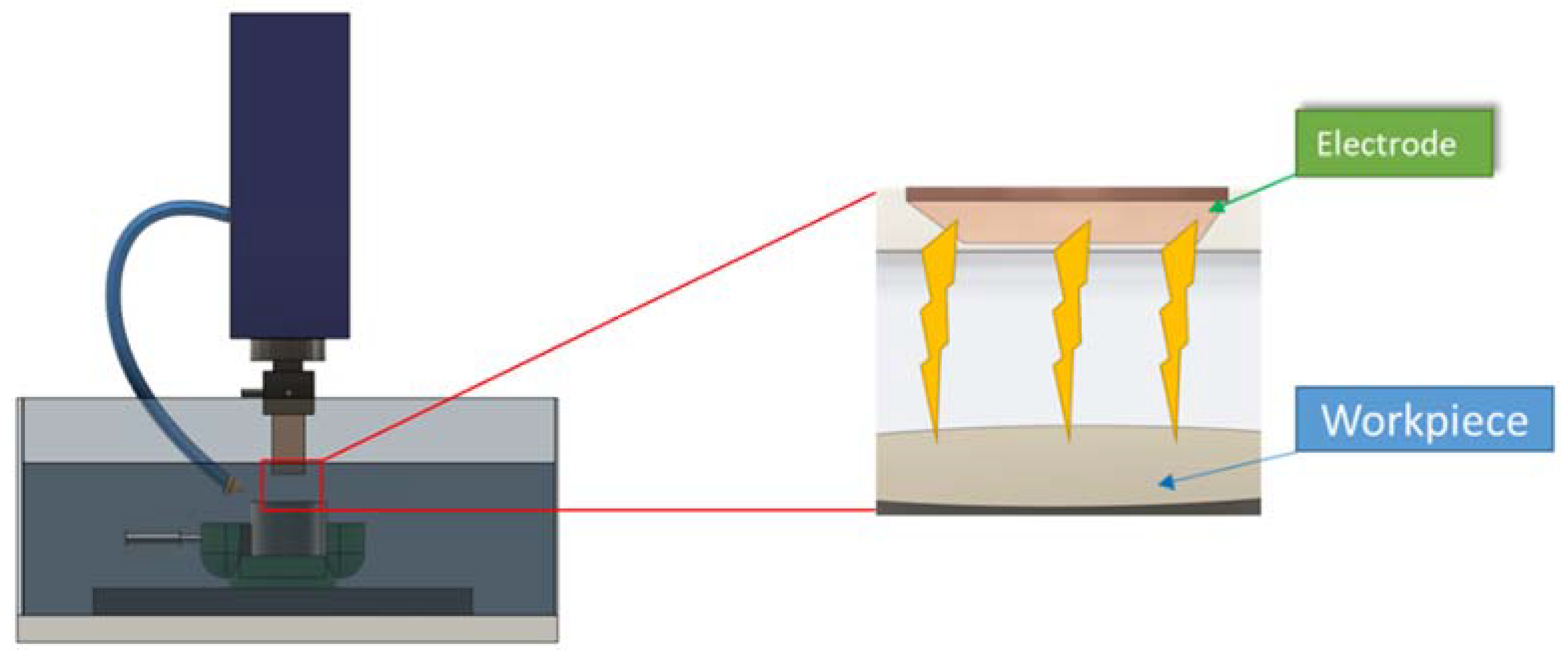

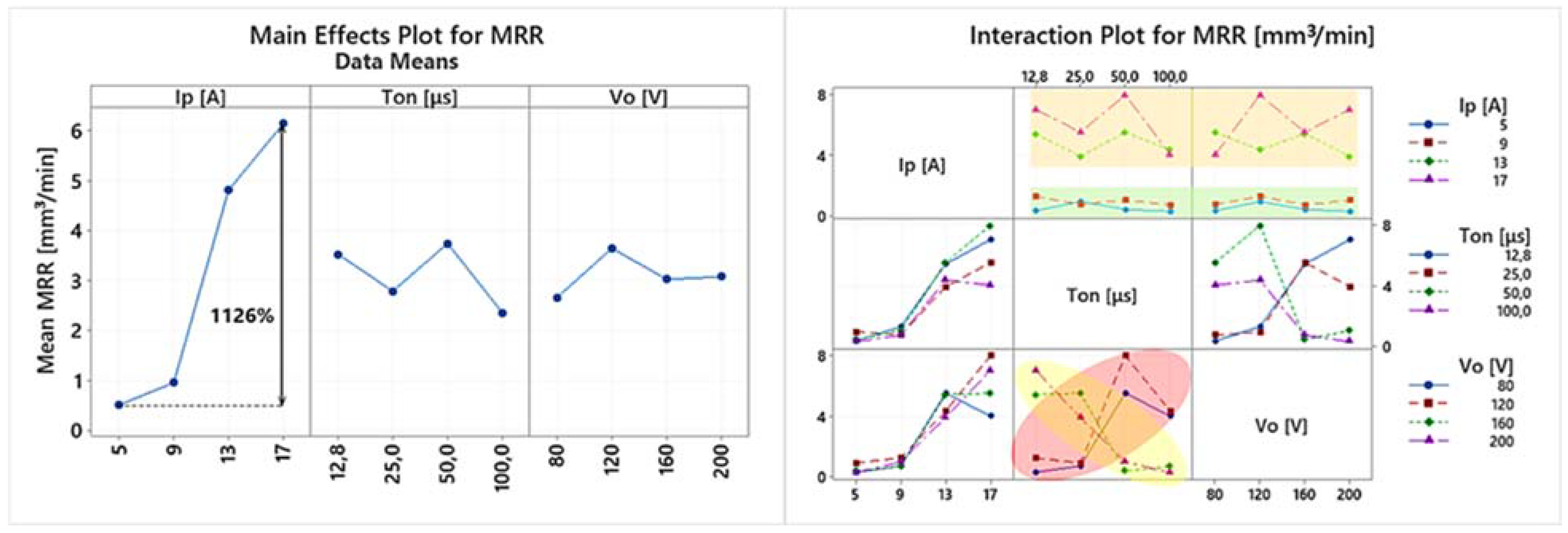

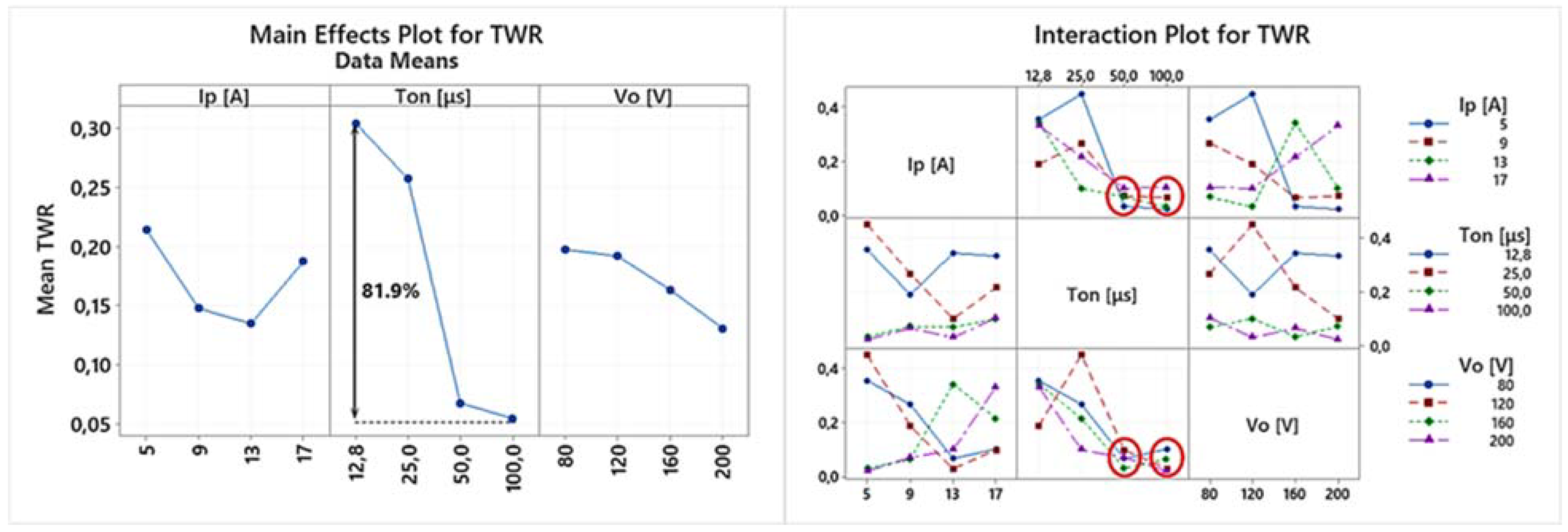
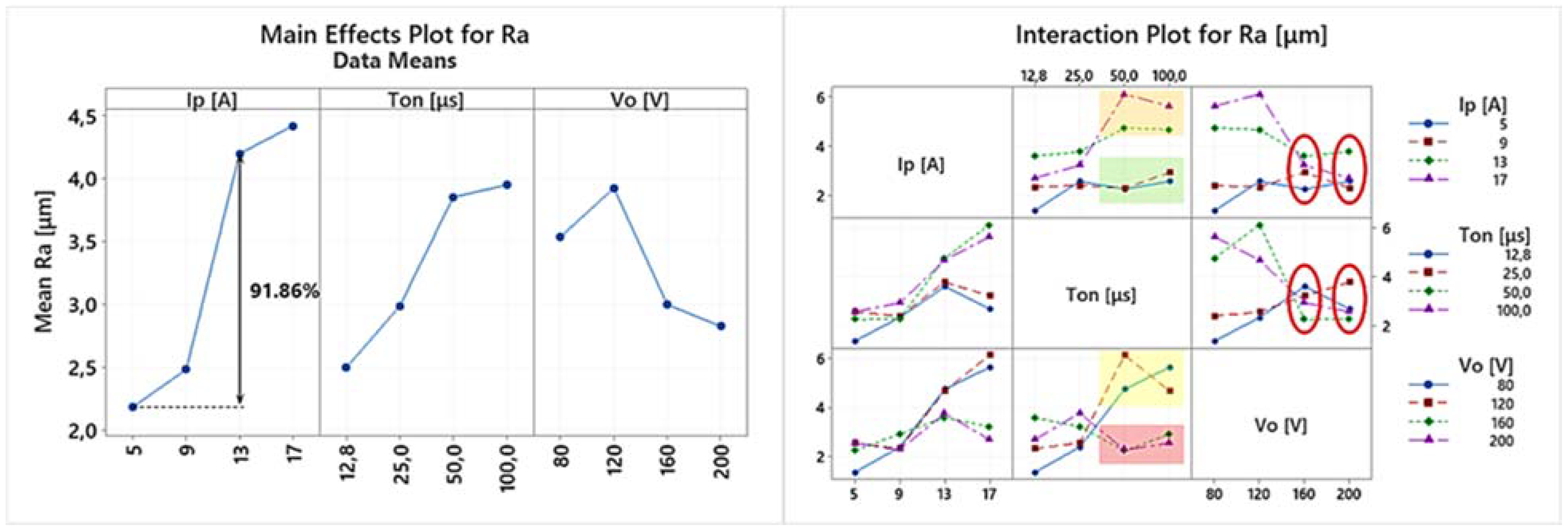
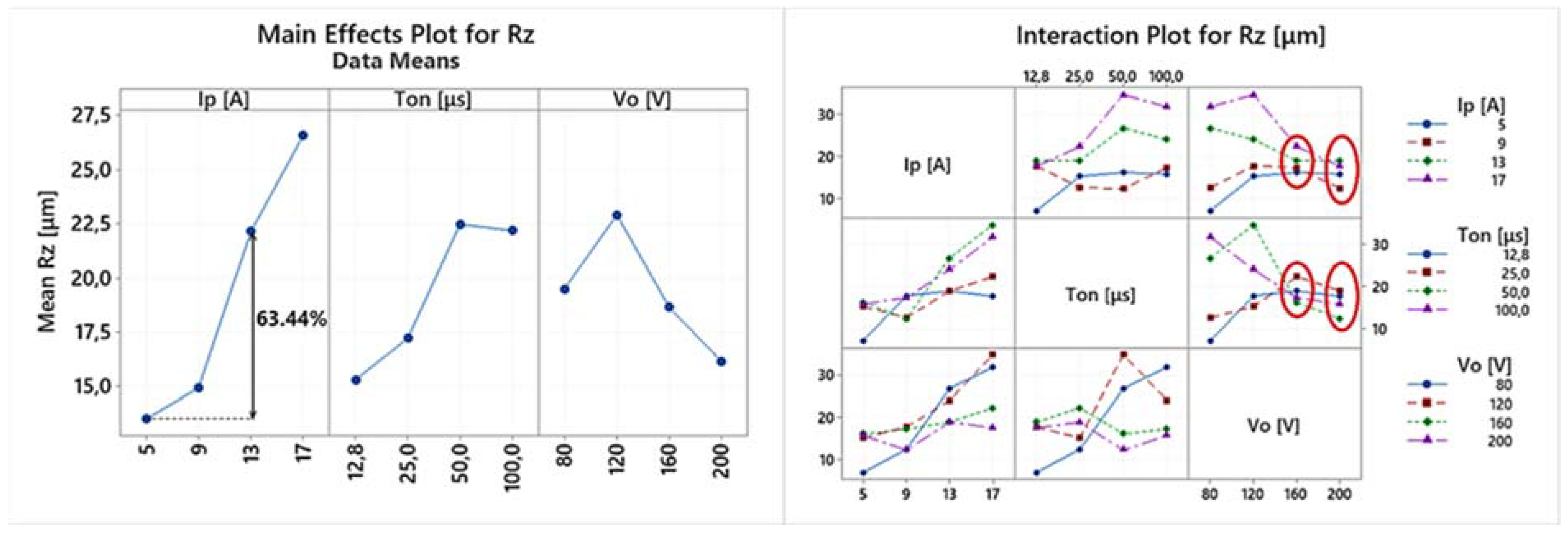
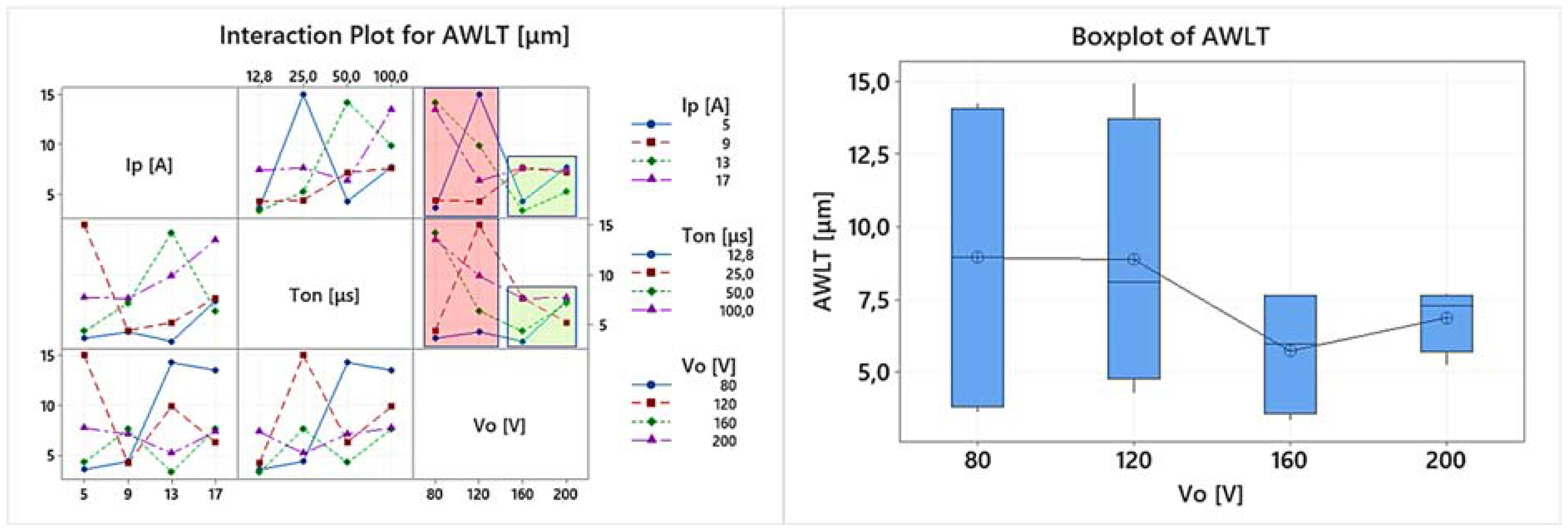
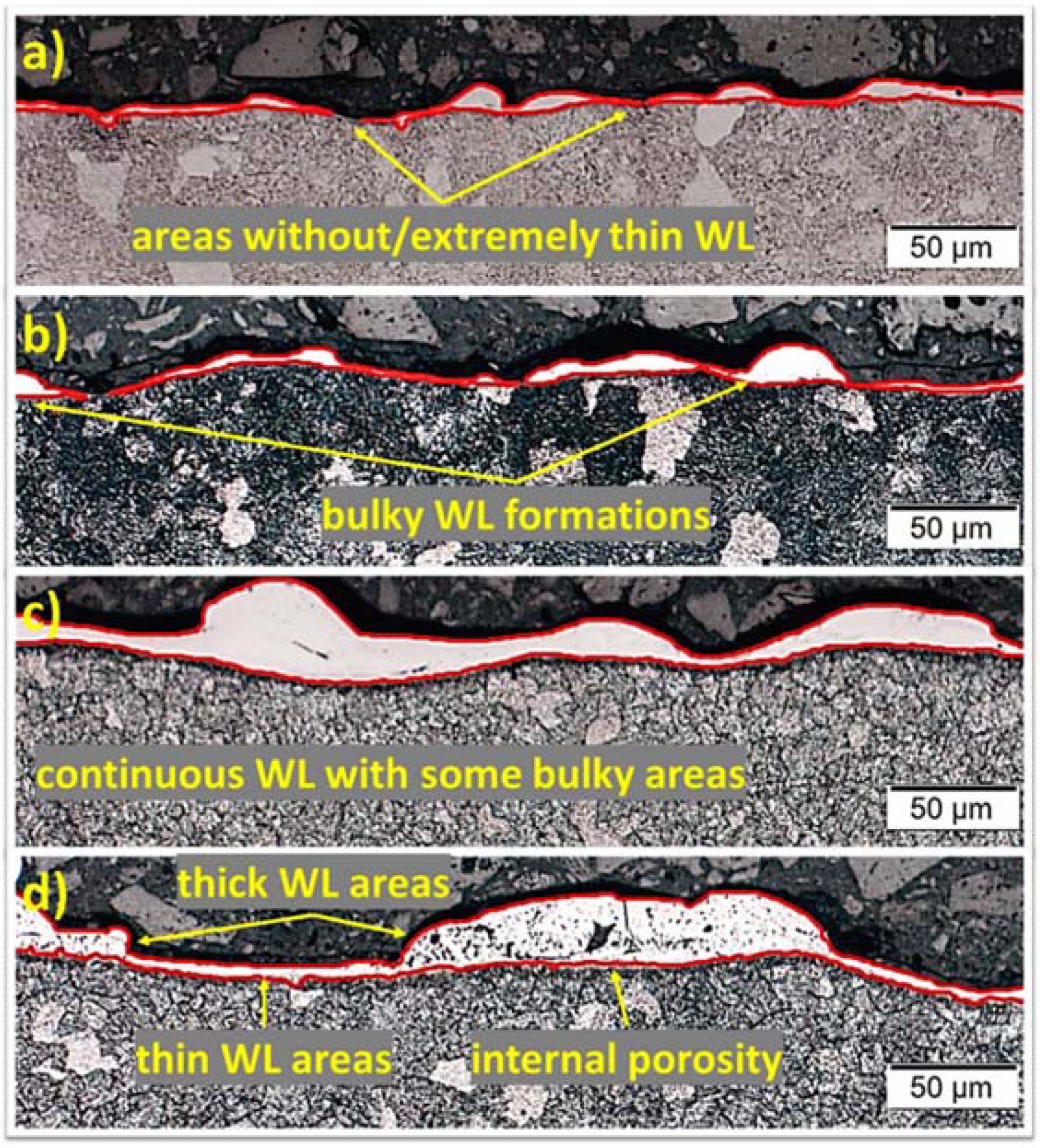
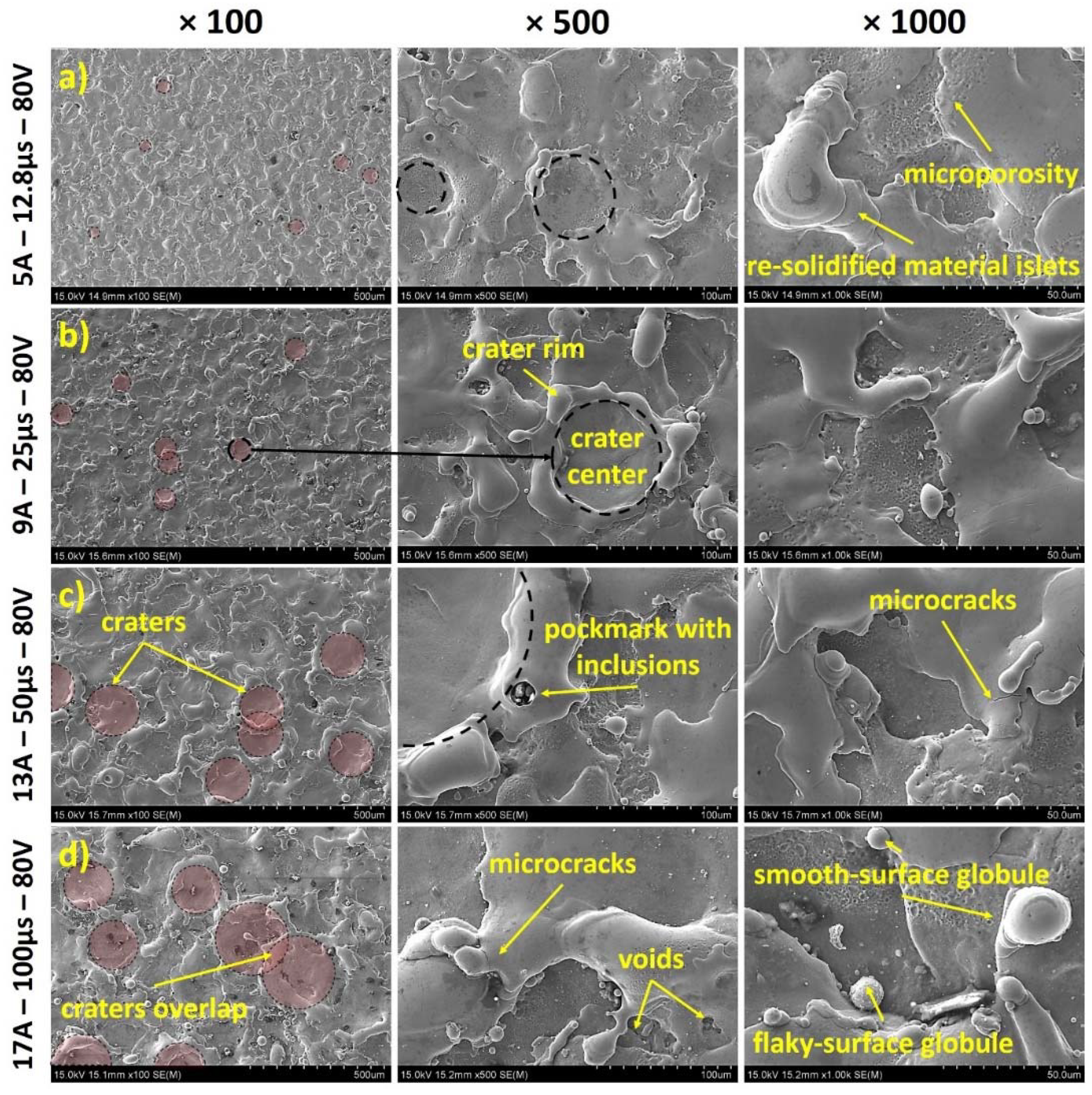
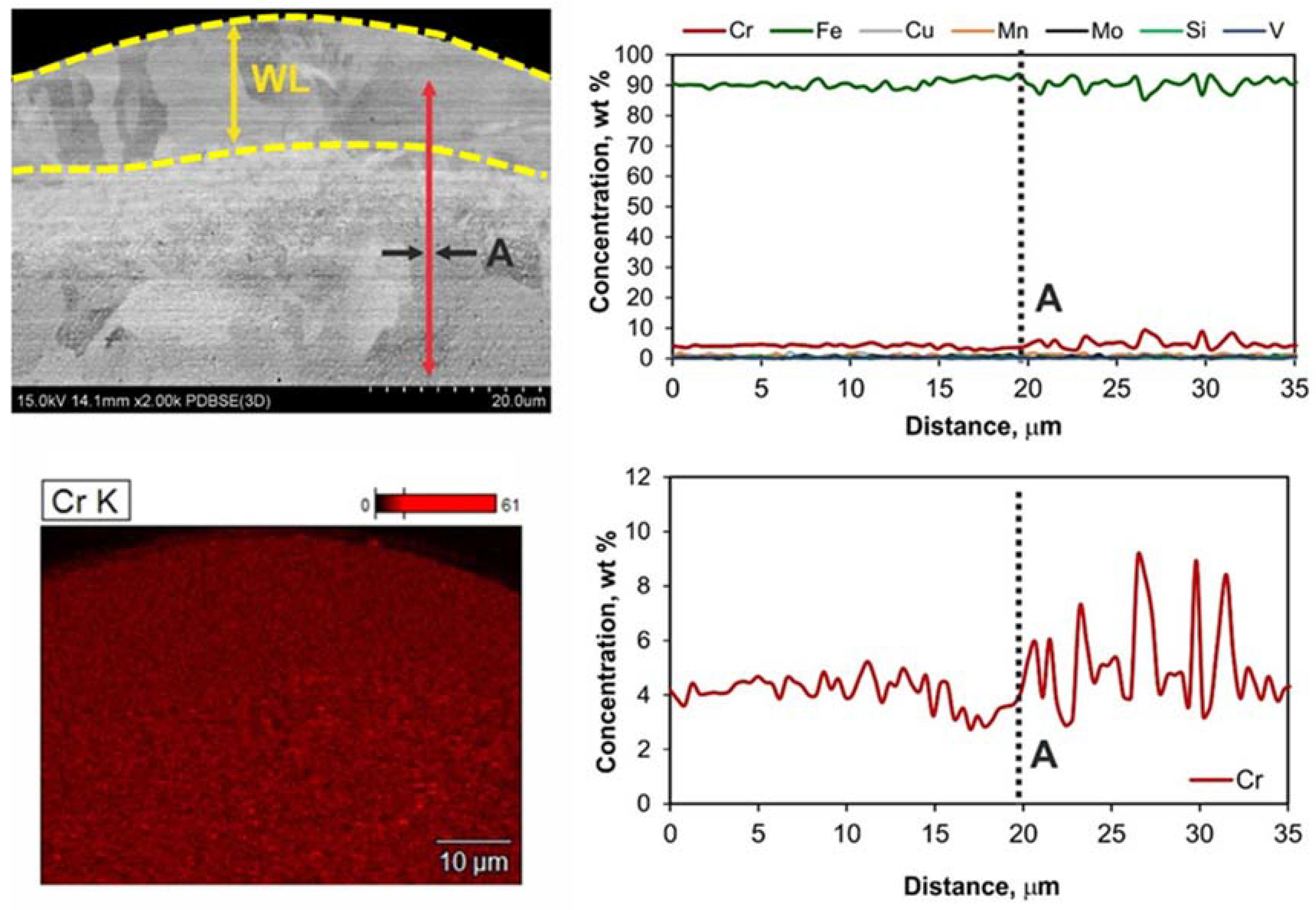
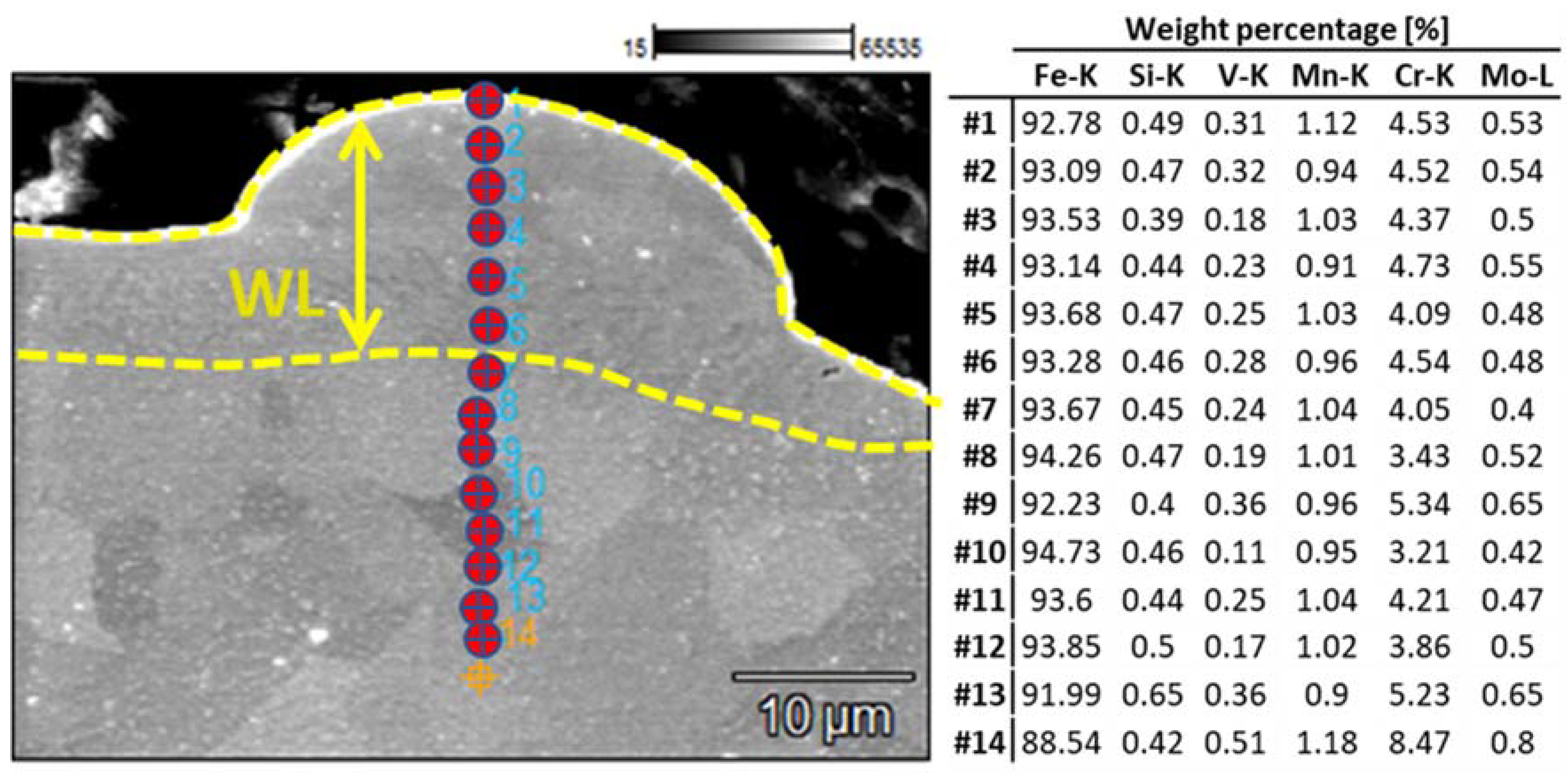
| Typical Analysis % | Fe | C | Si | Mn | Cr | Mo | V |
| bal. | 0.6 | 0.35 | 0.8 | 4.5 | 0.5 | 0.2 | |
| Physical Properties | |||||||
| Density [kg/m3] | 7770 | ||||||
| Thermal Conductivity [W/mK] | 27 | ||||||
| Specific Heat [J/kgK] at 293 K–473 K–679 K | 455–525–608 | ||||||
| Machining Conditions | Level 1 | Level 2 | Level 3 | Level 4 |
|---|---|---|---|---|
| Discharge current Ip [A] | 5 | 9 | 13 | 17 |
| Pulse on-Time Ton [μs] | 12.8 | 25 | 50 | 100 |
| Open-circuit voltage Vo [V] | 80 | 120 | 160 | 200 |
| Close circuit voltage Vc [V] | 30 | |||
| Duty Factor | 0.5 | |||
| Dielectric | Synthetic hydrocarbon fluid | |||
| Dielectric Flushing | Side flushing with pressure | |||
| Dielectric Flushing Pressure [MPa] | 0.7 (Constant under the whole conditions) | |||
| # EXP | Ip [A] | Ton [μs] | Vo [V] | # EXP | Ip [A] | Ton [μs] | Vo [V] |
|---|---|---|---|---|---|---|---|
| 1 | 5 | 12.8 | 80 | 9 | 13 | 12.8 | 160 |
| 2 | 5 | 25 | 120 | 10 | 13 | 25 | 200 |
| 3 | 5 | 50 | 160 | 11 | 13 | 50 | 80 |
| 4 | 5 | 100 | 200 | 12 | 13 | 100 | 120 |
| 5 | 9 | 12.8 | 120 | 13 | 17 | 12.8 | 200 |
| 6 | 9 | 25 | 80 | 14 | 17 | 25 | 160 |
| 7 | 9 | 50 | 200 | 15 | 17 | 50 | 120 |
| 8 | 9 | 100 | 160 | 16 | 17 | 100 | 80 |
| # EXP | MRR [mm3/min] | TMRR [mm3/min] | TWR | Ra [μm] | Rz [μm] | RSk | Rku | AWLT [μm] |
|---|---|---|---|---|---|---|---|---|
| 1 | 0.337 | 0.119 | 0.354 | 1.37 | 7.02 | −0.52 | 3.34 | 3.68 |
| 2 | 0.946 | 0.423 | 0.448 | 2.56 | 15.23 | −0.29 | 3.84 | 14.98 |
| 3 | 0.427 | 0.014 | 0.033 | 2.25 | 16.15 | 0.3 | 2.73 | 4.30 |
| 4 | 0.303 | 0.007 | 0.022 | 2.56 | 15.77 | −0.27 | 2.97 | 7.72 |
| 5 | 1.291 | 0.244 | 0.189 | 2.33 | 17.73 | −0.18 | 2.64 | 4.26 |
| 6 | 0.754 | 0.201 | 0.267 | 2.39 | 12.49 | 0.57 | 2.6 | 4.41 |
| 7 | 1.035 | 0.074 | 0.071 | 2.28 | 12.31 | 0.59 | 3.71 | 7.15 |
| 8 | 0.722 | 0.047 | 0.065 | 2.93 | 17.24 | 0.17 | 3.13 | 7.61 |
| 9 | 5.424 | 1.855 | 0.342 | 3.59 | 18.92 | −0.1 | 2.58 | 3.31 |
| 10 | 3.925 | 0.391 | 0.100 | 3.77 | 18.90 | 0.29 | 3.23 | 5.21 |
| 11 | 5.517 | 0.374 | 0.068 | 4.75 | 26.73 | 0.34 | 2.99 | 14.25 |
| 12 | 4.351 | 0.133 | 0.031 | 4.67 | 23.97 | 1.07 | 4.77 | 9.87 |
| 13 | 7.032 | 2.330 | 0.331 | 2.69 | 17.58 | 0.59 | 2.95 | 7.38 |
| 14 | 5.513 | 1.184 | 0.215 | 3.22 | 22.27 | 0.18 | 2.73 | 7.64 |
| 15 | 7.979 | 0.799 | 0.100 | 6.13 | 34.67 | 0.3 | 2.95 | 6.35 |
| 16 | 4.031 | 0.414 | 0.103 | 5.63 | 31.74 | 0.46 | 3.25 | 13.50 |
| Machining Parameters | Grey Relational Coefficients | Grey Relational Grades | |||||||
|---|---|---|---|---|---|---|---|---|---|
| Ip[A] | Ton [μs] | Vo [V] | MRR | TWR | Ra | AWLT | MRR TWR | MRR TWR–Ra | MRR–TWR Ra–AWLT |
| 5 | 12.8 | 80 | 0.334 | 0.391 | 1.000 | 0.940 | 0.363 | 0.575 | 0.666 |
| 5 | 25 | 120 | 0.353 | 0.333 | 0.666 | 0.333 | 0.343 | 0.451 | 0.422 |
| 5 | 50 | 160 | 0.337 | 0.952 | 0.730 | 0.855 | 0.645 | 0.673 | 0.719 |
| 5 | 100 | 200 | 0.333 | 1.000 | 0.667 | 0.570 | 0.667 | 0.667 | 0.642 |
| 9 | 12.8 | 120 | 0.365 | 0.561 | 0.712 | 0.860 | 0.463 | 0.546 | 0.624 |
| 9 | 25 | 80 | 0.347 | 0.465 | 0.700 | 0.841 | 0.406 | 0.504 | 0.588 |
| 9 | 50 | 200 | 0.356 | 0.813 | 0.723 | 0.603 | 0.584 | 0.631 | 0.624 |
| 9 | 100 | 160 | 0.346 | 0.834 | 0.604 | 0.576 | 0.590 | 0.595 | 0.590 |
| 13 | 12.8 | 160 | 0.600 | 0.400 | 0.517 | 1.000 | 0.500 | 0.506 | 0.629 |
| 13 | 25 | 200 | 0.486 | 0.734 | 0.498 | 0.754 | 0.610 | 0.572 | 0.618 |
| 13 | 50 | 80 | 0.609 | 0.824 | 0.413 | 0.348 | 0.716 | 0.615 | 0.549 |
| 13 | 100 | 120 | 0.514 | 0.962 | 0.419 | 0.471 | 0.738 | 0.632 | 0.591 |
| 17 | 12.8 | 200 | 0.802 | 0.408 | 0.643 | 0.589 | 0.605 | 0.618 | 0.610 |
| 17 | 25 | 160 | 0.609 | 0.525 | 0.563 | 0.574 | 0.567 | 0.565 | 0.568 |
| 17 | 50 | 120 | 1.000 | 0.732 | 0.333 | 0.657 | 0.866 | 0.688 | 0.681 |
| 17 | 100 | 80 | 0.493 | 0.726 | 0.358 | 0.364 | 0.609 | 0.526 | 0.485 |
Publisher’s Note: MDPI stays neutral with regard to jurisdictional claims in published maps and institutional affiliations. |
© 2022 by the authors. Licensee MDPI, Basel, Switzerland. This article is an open access article distributed under the terms and conditions of the Creative Commons Attribution (CC BY) license (https://creativecommons.org/licenses/by/4.0/).
Share and Cite
Karmiris-Obratański, P.; Papazoglou, E.L.; Leszczyńska-Madej, B.; Karkalos, N.E.; Markopoulos, A.P. An Optimalization Study on the Surface Texture and Machining Parameters of 60CrMoV18-5 Steel by EDM. Materials 2022, 15, 3559. https://doi.org/10.3390/ma15103559
Karmiris-Obratański P, Papazoglou EL, Leszczyńska-Madej B, Karkalos NE, Markopoulos AP. An Optimalization Study on the Surface Texture and Machining Parameters of 60CrMoV18-5 Steel by EDM. Materials. 2022; 15(10):3559. https://doi.org/10.3390/ma15103559
Chicago/Turabian StyleKarmiris-Obratański, Panagiotis, Emmanouil L. Papazoglou, Beata Leszczyńska-Madej, Nikolaos E. Karkalos, and Angelos P. Markopoulos. 2022. "An Optimalization Study on the Surface Texture and Machining Parameters of 60CrMoV18-5 Steel by EDM" Materials 15, no. 10: 3559. https://doi.org/10.3390/ma15103559
APA StyleKarmiris-Obratański, P., Papazoglou, E. L., Leszczyńska-Madej, B., Karkalos, N. E., & Markopoulos, A. P. (2022). An Optimalization Study on the Surface Texture and Machining Parameters of 60CrMoV18-5 Steel by EDM. Materials, 15(10), 3559. https://doi.org/10.3390/ma15103559









